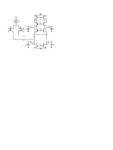deep_sea
Advanced Member level 4

Hello fellows,
I am wondering how to generate the biasing voltages of folded cascode (VG3,VG5,VG7,VG9)?
How to determine which voltage levels should be there and what circuit to generate?
I have tried current mirror for PMOS part but how to bias NMOS part?
Thanks in advance,
I am wondering how to generate the biasing voltages of folded cascode (VG3,VG5,VG7,VG9)?
How to determine which voltage levels should be there and what circuit to generate?
I have tried current mirror for PMOS part but how to bias NMOS part?
Thanks in advance,



